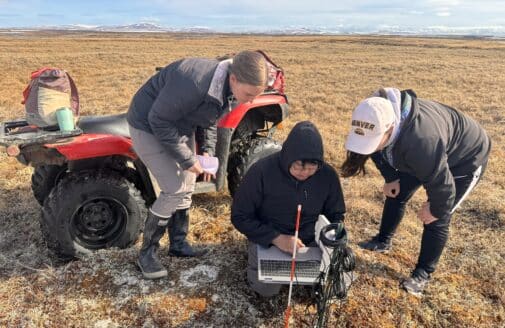Review of permafrost science in IPCC’s AR6 WG2

Exposed permafrost thaw in northeastern Siberia. / photo by Sue Natali
Introduction
In February 2022, the second installment of the International Panel on Climate Change (IPCC)’s Sixth Assessment Working Group 2 Report (AR6 WG2) was released; it focuses on the latest findings on climate change impacts and associated vulnerabilities and adaptation needs.
The Arctic is experiencing the most dramatic warming on the globe and is already facing the impacts of climate change. Much of the Arctic is underlain by permafrost, which is ground that has been frozen for at least two consecutive years. Permafrost stores vast amounts of carbon, almost twice as much as in the atmosphere. As discussed in AR6 WG2, thawing permafrost is a cascading threat that significantly increases vulnerabilities and risks for Arctic nations and Indigenous Peoples. Below, we examine the permafrost science and the impacts of thawing permafrost in the AR6 WG2 report.

Land subsidence caused by permafrost thaw in Nunapitchuk, Alaska.
Review
Impacts of permafrost thaw
- Wildfires will further contribute to permafrost thaw and carbon emissions.
- Thawing permafrost could increase vulnerabilities of Arctic communities and Indigenous Peoples by:
- Changing hydrology (including both local wetting and drying) and increasing water insecurity;
- Increasing the costs for maintenance and reconstruction of infrastructure;
- Damaging or causing loss of cultural heritage sites and livelihoods;
- Threatening economic activities, including food supplies and supply chains; and
- Causing migration and/or forced relocation due to decreased standard of living or deterioration of land.
- Other risks from thawing permafrost include gastrointestinal illnesses due to the reduced quality of surface waters, previously frozen disease (such as anthrax) outbreaks, and mercury entering food chains and water supplies.
- Already, some areas of Arctic permafrost have shifted from carbon sinks to carbon sources due to thaw.
Future risks of permafrost thaw
- Arctic ecosystems are among the “unique and threatened systems” that face high levels of risk without adaptation, with risk levels increasing further if temperatures reach 1.5°C.
- Thawing permafrost is a self-reinforcing feedback as the resulting emissions will drive further warming. Overshooting warming targets substantially increases carbon emissions from permafrost thaw. While uncertainties remain on the timing and magnitude, thawing permafrost has the potential to become a tipping point. As a tipping point, thawing permafrost could transform socio-ecological systems on a permanent and irreversible timescale.
- If warming reaches 2°C, the AR6 WG2 reports that it could reduce permafrost extent by 5-20%. Limiting warming to 1.5°C would prevent some losses. As stated, these projections may be underestimated as they do not account for deeper permafrost layers and abrupt permafrost collapse.
- There may be adaptation limits to permafrost thaw, especially for coastal communities, resulting in permanent loss and damage of Arctic lands.
Conclusion
As the IPCC stated in the Summary for Policymakers, “the cumulative scientific evidence is unequivocal: climate change is a threat to human well-being and planetary health. Any further delay in concerted anticipatory global action on adaptation and mitigation will miss a brief and rapidly closing window of opportunity to secure a liveable and sustainable future for all.” This is especially true for Arctic nations and Indigenous Peoples, who are facing growing threats from climate change. Support for adaptation efforts in the Arctic should be prioritized alongside mitigation efforts. For more information on permafrost science in AR6 WG1, please read our fact sheet.








